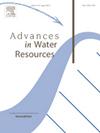Sensitivity analysis of key influencing factors for CO2 residual trapping within porous media
IF 4.2
2区 环境科学与生态学
Q1 WATER RESOURCES
引用次数: 0
Abstract
In this study, a pore-scale two-phase flow model is developed by coupling the Navier–Stokes equations with the phase-field method to investigate the effects of wettability, viscosity ratio (M), and drainage–imbibition cycles on CO2 residual trapping. Numerical simulations reveal that under unfavorable viscosity ratios (M < 1), the CO2 drainage front becomes unstable, while wettability significantly influences the two-phase drainage patterns. When the CO2 front breakthrough, strongly water-wet media exhibit lower initial CO2 saturation and higher inlet drainage pressure. After breakthrough, the inlet pressure in these media shows multiple peaks, with corresponding fluctuations in CO2 saturation at the pressure maxima. During forced imbibition, CO2 in the strongly water-wet medium undergoes initial residual trapping followed by transport and escape due to water phase expansion, resulting in a stepwise decline in residual CO2 saturation and indicating potential secondary transport behavior. The two-phase M in the reservoir environment is not the main factor dominating the drainage pattern and CO2 residual trapping efficiency. Strongly water-wet systems tend to form sparse, large-scale residual CO2 clusters, while weakly water-wet systems favor dense, small-scale distributions. An increased M suppresses jamming by enhancing viscous resistance in the non-wetting phase, thereby increasing the average droplet size. Simulations of the drainage-imbibition cycle show that residual CO2 droplets reduce the effective permeability of the porous medium, elevate the inlet pressure, and delay breakthrough phenomenon, which is beneficial for geological CO2 sequestration. However, the cycling process increases the escape risk of residual CO2 phase at the outlet, and the residual CO2 saturation tends to decrease with the number of cycles. The research results provide theoretical support for the capacity evaluation and risk management of geological CO2 storage.
多孔介质中CO2残留捕集关键影响因素敏感性分析
在本研究中,通过将Navier-Stokes方程与相场方法相结合,建立了孔隙尺度的两相流模型,研究了润湿性、粘度比(M)和排水-吸胀循环对CO2残留捕集的影响。数值模拟表明,在不利的粘度比(M <;1) CO2排水前缘变得不稳定,润湿性显著影响两相排水模式。当CO2锋面突破时,强水湿介质初始CO2饱和度较低,进口排水压力较高。突破后,这些介质的进口压力出现多个峰值,在压力最大值处CO2饱和度也出现相应的波动。在强制吸胀过程中,强水湿介质中的CO2经历了初始残余捕集,随后由于水相膨胀进行输运和逸出,导致残余CO2饱和度逐步下降,表明潜在的二次输运行为。储层环境中的两相M并不是决定排水方式和CO2残留捕集效率的主要因素。强水湿系统倾向于形成稀疏的、大规模的残余CO2簇,而弱水湿系统倾向于形成密集的、小规模的分布。增大的M通过增强非润湿阶段的粘性阻力来抑制堵塞,从而增大平均液滴尺寸。排吸循环模拟结果表明,残余CO2液滴降低了多孔介质的有效渗透率,提高了入口压力,延缓了突破现象,有利于地质封存CO2。但循环过程增加了出口残余CO2相的逸出风险,残余CO2饱和度随循环次数的增加呈下降趋势。研究结果为地质CO2封存能力评价和风险管理提供了理论支持。
本文章由计算机程序翻译,如有差异,请以英文原文为准。
求助全文
约1分钟内获得全文
求助全文
来源期刊

Advances in Water Resources
环境科学-水资源
CiteScore
9.40
自引率
6.40%
发文量
171
审稿时长
36 days
期刊介绍:
Advances in Water Resources provides a forum for the presentation of fundamental scientific advances in the understanding of water resources systems. The scope of Advances in Water Resources includes any combination of theoretical, computational, and experimental approaches used to advance fundamental understanding of surface or subsurface water resources systems or the interaction of these systems with the atmosphere, geosphere, biosphere, and human societies. Manuscripts involving case studies that do not attempt to reach broader conclusions, research on engineering design, applied hydraulics, or water quality and treatment, as well as applications of existing knowledge that do not advance fundamental understanding of hydrological processes, are not appropriate for Advances in Water Resources.
Examples of appropriate topical areas that will be considered include the following:
• Surface and subsurface hydrology
• Hydrometeorology
• Environmental fluid dynamics
• Ecohydrology and ecohydrodynamics
• Multiphase transport phenomena in porous media
• Fluid flow and species transport and reaction processes
 求助内容:
求助内容: 应助结果提醒方式:
应助结果提醒方式:


